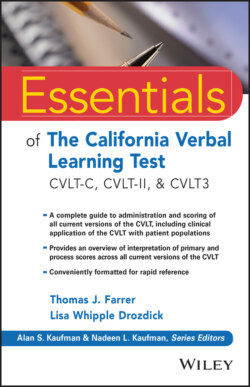Essentials of the California Verbal Learning Test

Реклама. ООО «ЛитРес», ИНН: 7719571260.
Оглавление
Thomas J. Farrer. Essentials of the California Verbal Learning Test
Table of Contents
List of Tables
List of Illustrations
Guide
Pages
Essentials of the California Verbal Learning Test
Essentials of the California Verbal Learning Test. CVLT-C, CVLT-II, & CVLT3
One OVERVIEW. INTRODUCTION
HISTORY AND DEVELOPMENT
OVERVIEW AND ORGANIZATION OF THE CVLT-C
Rapid Reference 1.1. Primary Scores Derived in CVLT-C, by Condition
OVERVIEW AND ORGANIZATION OF THE CVLT-II
Rapid Reference 1.2. Differences Between the CVLT-II Standard/Alternate Forms and the Short Form
Rapid Reference 1.3. Primary Scores Derived in CVLT-II, by Condition
OVERVIEW AND ORGANIZATION OF THE CVLT3
Rapid Reference 1.4. Changes from CVLT-II to CVLT3
Rapid Reference 1.5. Primary Scores Derived in CVLT3, by Condition
THEORETICAL FOUNDATION
Processes of Memory
Performance Validity
RESEARCH FOUNDATION. Standardization and Psychometric Properties
Rapid Reference 1.6. Stability Coefficients for 13 CVLT-C Scores, by Age
Rapid Reference 1.7. Stability Coefficients for CVLT-II Scores, by Age
Rapid Reference 1.8. Alternate Form Reliability for the CVLT-II
Rapid Reference 1.9. Alternate Form Reliability for the CVLT3 Core and Index Scores
CAUTION 1.1
COMPREHENSIVE REFERENCES ON TEST
Rapid Reference 1.10. Publication Data for CVLT-C
Publication Data for CVLT-II
Publication Data for CVLT3
A NOTE ON CVLT NOMENCLATURE
TEST YOURSELF
Two HOW TO ADMINISTER THE CVLT-C, CVLT-II, AND CVLT3
APPROPRIATE TESTING CONDITIONS. Testing Environment
Testing Materials
CAUTION 2.1. Materials Required for Administering the CVLT-C, CVLT-II, and CVLT3
TRIAL ADMINISTRATION SEQUENCE
CAUTION 2.2. Appropriate Delay Tasks
CAUTION 2.3
ADMINISTERING CVLT-II OR CVLT3 SHORT FORM
ADMINISTERING CVLT VIA TELEPRACTICE
DEVELOPING RAPPORT WITH EXAMINEES. Establishing Rapport
Maintaining Rapport
TESTING INDIVIDUALS WITH SPECIAL NEEDS
Rapid Reference 2.1. Modifications to the CVLT Administration to Accommodate an Examinee's Special Needs. Hearing Difficulties
Visual Difficulties
Motor Difficulties
Communication Difficulties
Non-English Speakers
Testing Older Adults
Rapid Reference 2.2. Recommendations for Selection of CVLT Forms
RULES OF ADMINISTRATION
Recording Responses
Rapid Reference 2.3. Common Abbreviations Used in Standardized Testing
CAUTION 2.4. Recording DK and NR Responses
Querying, Prompting, and Repeating
Rapid Reference 2.4. CVLT Prompts
DON'T FORGET 2.1. General Administration Tips
SPECIFIC TRIAL ADMINISTRATION GUIDELINES
Learning Trials (All CVLT Editions and Forms)
Interference Trial: List B (CVLT-II and CVLT3 Standard and Alternate Forms, CVLT-C)
30-Second Distractor Task (CVLT-II Short Form, CVLT3 Brief Form)
Short-Delay Free Recall (All Forms)
Short-Delay Cued Recall (CVLT-II and CVLT3 Standard and Alternate Forms, CVLT-C)
CAUTION 2.5
Delay (All Forms)
Long-Delay Free Recall (All Forms)
Long-Delay Cued Recall (All Forms)
Long-Delay Yes/No Recognition (All Forms)
Long-Delay Forced-Choice Recognition (All Forms of the CVLT-II and CVLT3)
DON'T FORGET 2.2. Common Examiner Mistakes
TEST YOURSELF
Three HOW TO SCORE THE CVLT-C, CVLT-II, AND CVLT3
CLASSIFYING RESPONSES ON RECALL TRIALS
Correct Responses
CAUTION 3.1
DON'T FORGET 3.1
Repetitions (Perseverations on CVLT-C)
Intrusions
Rapid Reference 3.1. Intrusion Categories Across Editions
DERIVING PRIMARY RAW SCORES. Primary Recall Measures
Rapid Reference 3.2. Primary Recall Scores Across Editions
Primary Recognition Measures
CAUTION 3.2. Scoring DK and NR Responses
Rapid Reference 3.3. Primary Recognition Scores Across Editions
DERIVING STANDARDIZED SCORES FOR PRIMARY MEASURES
DERIVING CVLT PROCESS SCORES
Rapid Reference 3.4. Process Scores Across Editions
Learning Characteristics
Semantic Clustering
Serial Clustering
Learning Slope
Primacy, Middle, Recency
Rapid Reference 3.5. Primacy, Middle, and Recency Differences Across Editions and Forms
Recall Consistency
Recall Error Measures. Intrusions and Repetitions
Novel and Across-/Within-Trial Repetition Errors
Contrast Measures
Rapid Reference 3.6. Contrast Measures Across Editions
Forced-Choice Recognition Measures (CVLT-II and CVLT3)
Additional Scores
Computer Scoring Procedures
TEST YOURSELF
Four INTERPRETATION OF THE CVLT
CAUTION 4.1
FACTORS THAT AFFECT INTERPRETATION
UNDERSTANDING SCORES FROM THE CVLT. DON'T FORGET 4.1
CAUTION 4.2
INTERPRETATION OF CVLT PRIMARY SCORES
Trial 1 Total Correct
Rapid Reference 4.1
Rapid Reference 4.2. Expectations for Trial 1
Trials 1–5 Total Correct
Interference Trial: List B (Standard and Alternate Forms Only)
Clinical Considerations
Short-Delay Recall. Short-Delay Free Recall
DON'T FORGET 4.2
Clinical Considerations
Short-Delay Cued Recall
DON'T FORGET 4.3
CAUTION 4.3
Long-Delay Recall. Long-Delay Free Recall
Clinical Considerations
Long-Delay Cued Recall
Yes/No Recognition
LEARNING CHARACTERISTICS
Clustering. Semantic Clustering
Serial Clustering
Clinical Considerations of Semantic Versus Serial Clustering
CAUTION 4.4
Subjective Clustering
Learning Slope
Rapid Reference 4.3. Clinical Considerations in Learning Slope
Recall Order Effects. Primacy and Recency Recall Scores
CAUTION 4.5
Recall Consistency
Rapid Reference 4.4. Relevant Definitions
Trials 2–5 Total Correct
Rapid Reference 4.5. Learning Slope
RECALL ERRORS
Repetitions and Perseverations
Intrusions
Rapid Reference 4.6. Intrusion Types
DON'T FORGET 4.4
PERFORMANCE VALIDITY (CVLT-II AND CVLT3)
TEST YOURSELF
Five STRENGTHS AND WEAKNESSES OF CVLT
CVLT STRENGTHS AND WEAKNESSES
Rapid Reference 5.1. Strengths and Weaknesses of the CVLT
STRENGTHS AND WEAKNESSES OF THE CVLT-C
Rapid Reference 5.2. Strengths and Weaknesses of the CVLT-C
STRENGTHS AND WEAKNESSES OF THE CVLT-II
Rapid Reference 5.3. Strengths and Weaknesses of the CVLT-II
STRENGTHS AND WEAKNESSES OF THE CVLT3
Rapid Reference 5.4. Strengths and Weaknesses of the CVLT3
TEST YOURSELF
Six CVLT PERFORMANCE IN CLINICAL POPULATIONS
CVLT-II AND CVLT3 IN CLINICAL POPULATIONS
Memory Decline
Alzheimer's Disease and Amnestic MCI
Rapid Reference 6.1
Huntington's Disease and CVLT
Rapid Reference 6.2
Parkinson's Disease
Rapid Reference 6.3
Differentiation of Clinical Groups
Memory Change Due to Injury to the Central Nervous System. Traumatic Brain Injury
Rapid Reference 6.4
Psychiatric Disorders and Memory. Depression
Rapid Reference 6.5
Schizophrenia
Rapid Reference 6.6
CVLT-C IN CLINICAL POPULATIONS
School-Based Assessments
Attention Deficit/Hyperactivity Disorder
Rapid Reference 6.7
Learning Disability
Rapid Reference 6.8
Healthcare-Based Assessments
Down Syndrome
Rapid Reference 6.9
Pediatric Traumatic Brain Injury
Cancer and Cancer Treatment
Rapid Reference 6.10
TEST YOURSELF
Seven ILLUSTRATIVE CASE REPORTS
CASE 1 (S.R.)—TYPICAL MEMORY
CASE 2 (D. B.)—PROBABLE ALZHEIMER'S DISEASE
CASE 3 (J. L.)—PARKINSON'S DISEASE
CASE 4 (N.C.)—MULTIPLE SCLEROSIS
CASE 5 (G. G.)—MILD TRAUMATIC BRAIN INJURY: PEDIATRIC CASE
CONCLUSION
References
Author Index
Subject Index
WILEY END USER LICENSE AGREEMENT
Отрывок из книги
Series Editors, Alan S. Kaufman and Nadeen L. Kaufman
Essentials of 16PF® Assessment
.....
Essentials of MMPI-2® Assessment, Second Edition
by David S. Nichols
.....